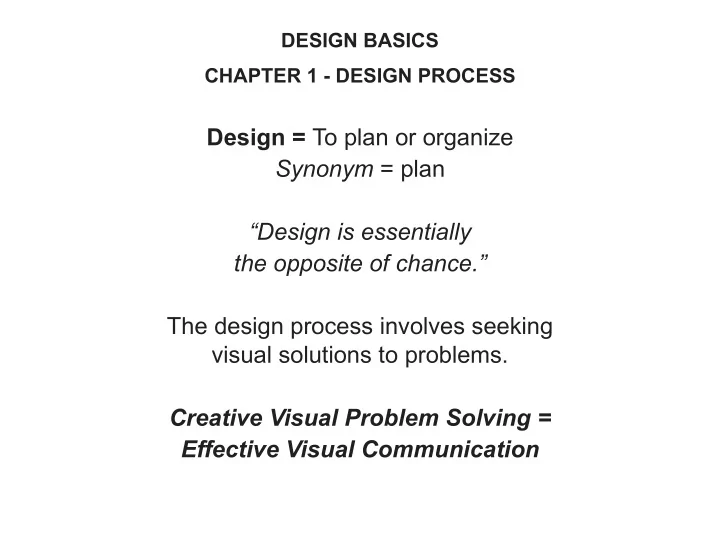

DESIGN BASICS ChAptEr 1 - DESIGN proCESS Design = To plan or organize Synonym = plan “Design is essentially the opposite of chance.” The design process involves seeking visual solutions to problems. Creative Visual Problem Solving = Effective Visual Communication
t - F “There are no rules in design!” The arts are called “creative fjelds” because there are no predetermined correct answers. there are guidelines, though. “However, the ‘no rules’ phrase does not mean that all devices are equally valid and visually successful.” “Design practices and criteria have been developed from successful works.” In other words you should look at and learn from the work of other designers. Look at what has worked and what has not worked.
CoNtENt AND Form 2 concepts exist simultaneously and interact. Content – The subject matter, the story, or info the that the artwork/design tries to communicate. (Content = What is being said. ) Form – The purely visual aspect. How it looks. Measurable. Described in terms of elements and principles. (Form = How it being said.)
Look up the word root and similar words. Content Form
“Aesthetic” When a piece does not have a message, the artwork is just for ‘aesthetic’ purposes. (In other words, it’s just meant to look nice .) “beauty” Pure abstraction has a very legitimate role in art. Most art is supposed to be a form of visual communication. (Especially in graphic design and web design.) “Aesthetic” the aspect of “beauty” separate from content or message.
Is all design a form of visual communication? no a well designed chair a well designed room how about : good design - through form - enhances function function can be : communication function can be : expression function can be : any experience or use most often : practical
As a designer you are a problem solver. Successful solutions are visually effective, and communicate ideas. What is the problem at hand. Goals - What is to be achieved? Content - What is to be included? Format – Size, color, medium, etc… Style – Illustration, Abstract, nonobjective, etc… Schedule – When must it be fjnished? A successful design communicates an idea… and or enhances the clarity of communication.
the Creative process: Thinking - Looking - Doing You don’t have to do these in order. They can happen in any order or at any time. (and can be repeated) Thinking - Looking - Doing Concept - Observe - Action Idea - Compare - Implement
1. thinking About the problem. Precisely what is to be achieved? (What specifjc visual or intellectual effect is desired?) Are there visual stylistic requirements? (Illustrative, abstract, nonobjective, and so on?) What are the physical limitations? (Size, color, media…) When is the solution needed? 2. thinking About the Solution How can the concept be shown?
StEpS IN thINkING: Make a list of ideas (symbols) that could represent / convey the theme or idea. Quickly sketch them. Expand the list - discussion or research. Narrow the list down to a few ideas. How will your idea be conveyed in a unique or original way. Audience - who is going to see your design? (a consideration of function)
“Form FollowS FuNCtIoN” “Communication is least ambiguous when the relationship between form and concept is clear and uncluttered.” What this famous quote expresses is: The shape / form of an object should come after (be a result of) designing it to work correctly (function). Thursday follows Friday
rECENt ExAmplES oF “upDAtED DESIGNED FormS” can openers - scissors baby bottles pens - toothbrush Bigger Handles! ergonomic chairs IKEA - sells pleasing functional forms (aesthetically designed products for the home or offjce)
II. lookING resources / references for Form and Content NAturE - Bones, animals, landscapes, etc… hIStory - Events, other artworks and artists, vernacular images etc… CulturE - TV, society, fashion, etc… othEr - ?
Visual training (and retraining) Visual Training often relies learning and relearning ways to look at things. A good designer should sees things in ways that the average viewer may not. They have “insight”. “look Again” Part of this is looking from different angles at different times through a different set of lenses.
III. DoING: thINkING wIth mAtErIAlS / toolS Doing starts with visual experimentation… and with visual “play” … Two Points of view: Materials / Tools are lifeless until given shape by a creator. Materials / Tools by their own potential create their end.
Thinking with Materials / Tools: Ways to do this include: trial and Error Intuition Application of a System (set of limitations or rules)
Doing and redoing: Revision is necessary. Starting over is sometimes necessary. Doing can take on a life of its own. Revision - Refjnement - Modifjcation - Corrections - Edits - Variations allows for an idea to grow beyond the obvious or familiar
IV. CrItIquE: CoNStruCtIVE CrItICISm Critique is a VERY important part of design. Forms of critique Self – Critique - self dialogue Review by peers or classmates Dialogue with a Professor
A model for Critique: Description – A verbal or spoken account of what is there. Analysis – A discussion of how things are presented. Including thoughts of how things are contrasted or different. Ex: Bigger than, brighter than, to the left of Interpretation – What is the meaning, implication, or effect of the piece.
Recommend
More recommend